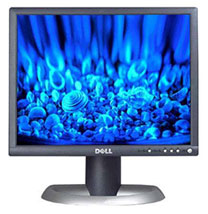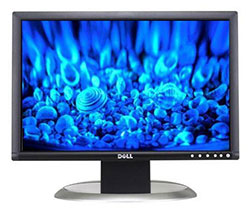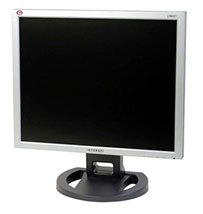Buyer's Guide: Mid-Range to High-End, May 2005
by Jarred Walton on May 23, 2005 5:30 PM EST- Posted in
- Guides
Display Recommendations
Before we get to the actual display recommendations, we have to say that the end of the CRT era is upon us. No matter how much you like your 21" CRT running at 2048x1536 resolution with a high refresh rate, there's a very good chance that the next major display upgrade that you make will be to an LCD. Why? It's simply a matter of reduced profit margins. In fact, looking at the current CRT landscape, we can see that specifications have fallen off quite a bit in the past few years.We used to look at 19" models that could run 1600x1200 at 85 Hz or higher, and quality 17" models frequently supported 1600x1200 at 75 Hz. Today, the best new 17" models support 1280x1024 at 67 Hz (which means that you'll run them at 60 Hz or else drop down to 1152x864 to get 75 Hz). 19" models still support 1600x1200 and sometimes higher resolutions, but only at 75 Hz or lower refresh rates. Even the 21" models have diminished in quality. The Mitsubishi Diamond Pro 2070 had a 140 kHz horizontal scan rate, allowing for 2048x1536 at 85 Hz or 1600x1200 at 115 Hz.
Unless you want to buy a refurbished display, you'll have difficulty finding a monitor that can beat those specs now. The NEC FE2111SB has a 115 kHz horizontal scan rate, limiting it to 85 Hz at 1600x1200 or 75 Hz at its maximum 1920x1440 resolution. Competing models are similar in specifications if not worse. In short, though the top CRTs still offer reasonable performance for the price, they're a dying breed. If you love CRTs - particularly the large models - we'd suggest that you try to find a Diamond Pro 2070 or NEC FP2141SB (the NEC model seems to be quite a bit more expensive, but specifications are nearly identical to the 2070). We've found the 2070 for around $650, but quantities are limited and you may not be purchasing a new display.
Unless we see a new CRT that actually boasts better specs than the older models, we're going to move on to recommending LCDs for the Mid-Range and High-End price segments. Prices have dropped to the point where most people will prefer an LCD to a CRT anyway. The displays have a perfectly flat surface and there are no geometry problems - no more worries about trying to adjust the pin-cushioning, convergence, rotation, etc. You also get to deal with a 10- to 20-pound display rather than a 40- to 85-pound display. There are still issues with pixel response times, color reproduction, and contrast ratios, but with CRTs devolving and LCDs improving, we expect that LCDs will dominate the market in the future.
Mid-Range Display
19" LCD: Hyundai Imagequest L90D+
Price: $350 Shipped
People on a budget might still prefer a good 19" CRT, which can save about $100 on the cost of the display. We prefer working with LCDs, however, and we've selected one of the best LCDs currently available. (Hopefully, we'll get a review of one soon.) You can find cheaper 19" LCDs, but we're interested in quality as well, and the L90D+ delivers. With an advertised 8ms response time, even the worst case gray-to-gray transitions are fast enough to all but eliminate motion blur. The monitor also has a pivot function and reasonable cable management, and of course, it has a DVI connection. It has a standard VGA D-SUB input as well, though we wouldn't recommend using that, and the integrated speakers are present, but they're not very useful. The one major drawback: this is a 6-bit panel, so there is interpolation present to "mimic" 16.2 million colors. It's still the best 19" LCD that you'll find for gaming, however.
If you want alternatives, the Dell 1905FP is also a reasonable option, and sometimes it can be found for under $300. Motion blur is present on the 1905FP, but depending on your sensitivity to such things, it may or may not be useable for gaming. There are quite a few models selling for under $350, but we would stay away from anything with more than a 16ms response time, and DVI-D input is a must for LCDs. We would also try to get a true 8-bit panel rather than one that uses interpolation. That eliminates most of the other options, unfortunately. One thing that we always advise with LCDs is to try the display out in person if at all possible - if you purchase it at a local store, you can verify that there are no dead pixels present before leaving the premises, which may be more important than the savings offered by purchasing online.
Note: We've had several notes in this Guide, but we feel they're all important. The Hyundai L90D+ currently uses a Samsung panel. However, Hyundai could change panel providers at any time if they feel there is a benefit in doing so. The Samsung 915N uses this same panel, and you can now read our review. The L90D+ adds the DVI input we wanted, and hopefully they continue to use this panel.
 |
 |
|
| Click images to enlarge. | ||
High-End Display
20" LCD: Dell 2001FP/2005FPW
Price: About $530
Dell offers both their widescreen and standard 20" diagonal LCDs for around the same price, and while we prefer the 2001FP for computer work, some people like the 16:9 aspect ratio on the 2005FPW more. Gamers will probably have better luck with the 2001FP, although if you look around, there are tweaks to get widescreen support in many games these days. The problem is getting support for the uncommon 1680x1050 resolution of the 2005FPW. If you're not particularly interested in gaming, it's not as big of a concern. Just remember that the actual screen real-estate of the 2001FP is slightly larger than the 2005FPW: 1,920,000 vs. 1,764,000 pixels.
Other than those points, the monitors perform about the same and cost about the same. Note that on the price, we say "about $530" - if you're patient and look around, Dell often comes out with some great rebates that can drop the cost to below $500. Still, $530 is a great deal for such a display. With 16ms advertised response times, most people will be able to play games, watch movies, etc. without noticing too much "motion blur" (i.e. blurriness caused by delays in the pixels switching between varying color levels). If you're really picky about such issues, try before you buy, as even the fastest LCDs don't update as fast as a good CRT. Over time, you'll probably grow accustomed to the LCD display - most of us have, and we really like many of the other benefits that LCDs offer.
We'd like to see some 21" and larger LCDs with good resolutions at an affordable price, but so far, most models above 20" other than the Dell are extremely expensive, offer lesser specs, or both. Dell offers their 24" widescreen 2405FPW with a native resolution of 1920x1200 for around $1200, which is probably the best price that you'll find for specs like that. Dell has become the 800 lbs. gorilla of the LCD market, after all. Most people would love to have such a display, or perhaps even a couple Apple 23" or 30" Cinema Displays, but reality prevents us from actually going that extreme.











60 Comments
View All Comments
Tujan - Tuesday, May 24, 2005 - link
Err a,thanks for reply..Calin.bummer when I do that.
Garyclaus16 - Tuesday, May 24, 2005 - link
All this article tells me is that my once 'bleeding edge' [939 Athlon64 3200+]system is now merely a mid range PC...save for my pqi turbo 2-2-2-5 :PStill...I am sad...I need to save up another 2k now for later this year. > :(
Tujan - Tuesday, May 24, 2005 - link
Thanks for reply Chris..Yeah Ive followed a few stories about the VIA Edens. Just hovering around 1 GHz. With single PCI slot.They too,have onboard graphics. Like pull that off , keep onboard sound maybe,...
Certainly limiting themselves with that kind of choice.Then Im not what that is suppose to reach. Two PCI-e slots at minimum for me.But this sends the engineers back to work.
Most vendors Iv seen include the graphics onto the mini-atx motherboards. MSI has an mini-atx w/o graphics ,..775.But isn't seen at vendors. Situation with the power,could make do with feature set of 915..945,955/Nvidias on mini-atx(s),.Since the lan is onboard.Might consider having maybe single Sata as well.
Not like being able to see clearly now...""I can see clearly now the rain is gone""..:)
Weird how we will see magic in closed black box embedded solution before we have that choice.
ProviaFan - Tuesday, May 24, 2005 - link
I agree with #34 for the most part, but anyone heavily into digital photography (whether with DSLR or scanned film) knows that it is very easy to exceed 1GB with Photoshop and a few images with some adjustment layers and layer masks (not to mention that my PC is general purpose and I usually have other stuff going in the background as well).stickx - Tuesday, May 24, 2005 - link
quoted from the guide: "long-time favorite, the OCZ Rev. 2 Platinum. While the price increase is quite drastic, it's worth mentioning that this same RAM cost as much as $275 just a few months back. It uses Samsung TCCD memory blanks"Unfortunately OCZ is no longer using TCCD memory in this product. This has been verified on several forums in xtremesystems.org and in dfi-street.com where people have removed the heat spreaders to find chips other that TCCD. I think you need to update your guide for this info.
OrSin - Tuesday, May 24, 2005 - link
Damn people get off thier backs. It a damn guide. Make all the choices you. They are giving thier recommondation, they are not give you ever fcking choice under the sun. No guide can have everyones choice.And ars, I don't know what planet your from but if you think epox is even near Asus or MSI in quality then then you full of it. If i saw any sit say Exop is better then ASUS, then I would stop reading them. Better then chaintech ost likely then not the top tier guys.
And for the record I play alot games and have noticed no improvement with 2GB of 1GB or memory.
Don know what you do thet 2GB is needed. Now I'm not saying you can;t find a way to use more then 1GB, but how many people actually do and on a regular bases.
Pythias - Tuesday, May 24, 2005 - link
When you guys refer to response time, is thet grey-to-grey, black-white-black, or total response time?MrOblivious - Tuesday, May 24, 2005 - link
Supposedly the issue with MSI NEO4 boards and 90nm chips has been fixed:http://forum.msi.com.tw/index.php?topic=80384.0
arswihart - Tuesday, May 24, 2005 - link
Kris - so you are now saying all mobo makers are essentially equal in terms of support, upgrades, MTBF (bad caps excuse is dead now since they all use good/great quality caps). So what's left to make me choose Asus/MSI? If you are saying reputation, I can just direct you to the forums, their boards are no better or worse than any of the competition. If you are recommending based on sales, thats just dumb.ceefka - Tuesday, May 24, 2005 - link
#1 I don't know how the onboard will handle sound in games, but I'd count on it to do that on the level it is built, i.e. no better than it will play a CD or DVD. It is however safe to say that onboard will definately not work for (semi)professional audio on a PC.I always thought that any realtime sound effects were handled by the CPU, unless you have a dedicated DSP-card or multiples thereof which gamers seldom do ;-)
Jarred: "anyone who doesn't intend to do any recording of audio" and what about those that do? I do read a lot about DAW's on the net, but have to get back to AT regularly to get a the details straight.
What do you make of this? http://www.rme-audio.com/english/techinfo/nforce4_...
With the Thonex audio stress test file (downloadable from http://www.adkproaudio.com/downloads.cfm), including memory-intensive data communication via samples/VSTis, and used with Cubase SX/Nuendo 2/3, soundcard latency has to be increased to approx. 2048 samples buffer latency setting with the NF4 to receive glitch-free audio recordings whereas with the NF3, and equivalent software/hardware/soundware equipment, the minimum latency can be significantly reduced (some 128-256 samples). Likewise, cpu load values are significantly higher with the NF4 than with the NF3 ditto - based on exactly the same audio stress test files and equivalent hardware peripherals.
The Thonex could be nice for your next high end guide when the dualcores are out.